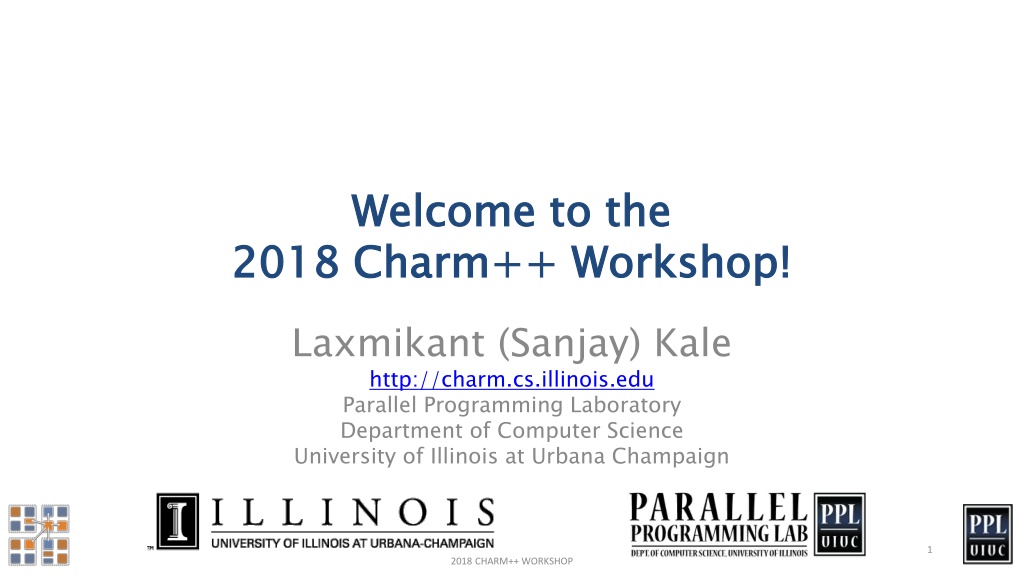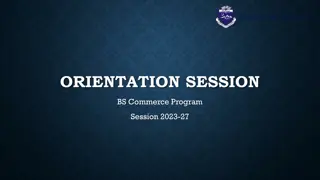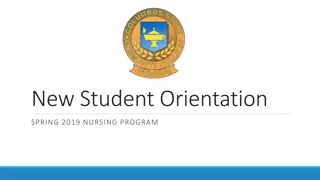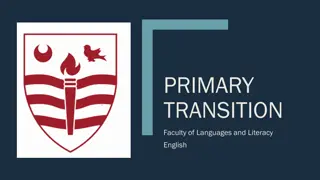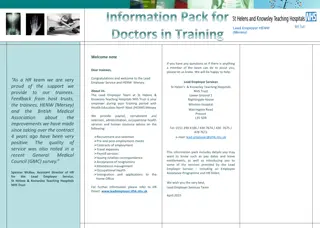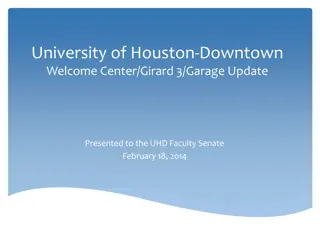Introduction to Charm++ Programming Framework
Charm++ is a generalized approach to parallel programming that offers an alternative to traditional parallel programming languages like MPI, UPC, and GA. It emphasizes overdecomposition, migratability, and asynchrony to enhance parallel program performance and efficiency. The framework uses indexed collections called chares for communication through asynchronous method invocations, enabling scalable and adaptive parallel programming.
Download Presentation

Please find below an Image/Link to download the presentation.
The content on the website is provided AS IS for your information and personal use only. It may not be sold, licensed, or shared on other websites without obtaining consent from the author.If you encounter any issues during the download, it is possible that the publisher has removed the file from their server.
You are allowed to download the files provided on this website for personal or commercial use, subject to the condition that they are used lawfully. All files are the property of their respective owners.
The content on the website is provided AS IS for your information and personal use only. It may not be sold, licensed, or shared on other websites without obtaining consent from the author.
E N D
Presentation Transcript
Welcome to the 2018 Charm++ Workshop! Laxmikant (Sanjay) Kale http://charm.cs.illinois.edu Parallel Programming Laboratory Department of Computer Science University of Illinois at Urbana Champaign Welcome to the 2018 Charm++ Workshop! 1 2018 CHARM++ WORKSHOP
What is Charm++? Charm++ is a generalized approach to writing parallel programs An alternative to the likes of MPI, UPC, GA etc. But not to sequential languages such as C, C++, Fortran Represents: The style of writing parallel programs The adaptive runtime system And the entire ecosystem that surrounds it Three design principles: Overdecomposition, Migratability, Asynchrony 2018 CHARM++ WORKSHOP 2
Overdecomposition Decompose the work units & data units into many more pieces than execution units Cores/Nodes/.. Not so hard: we do decomposition anyway 2018 CHARM++ WORKSHOP 3
Migratability Allow these work and data units to be migratable at runtime i.e. the programmer or runtime, can move them Consequences for the application developer Communication must now be addressed to logical units with global names, not to physical processors But this is a good thing Consequences for RTS Must keep track of where each unit is Naming and location management 2018 CHARM++ WORKSHOP 4
Asynchrony: Message-Driven Execution With over decomposition and Migratibility: You have multiple units on each processor They address each other via logical names Need for scheduling: What sequence should the work units execute in? One answer: let the programmer sequence them Seen in current codes, e.g. some AMR frameworks Message-driven execution: Let the work-unit that happens to have data ( message ) available for it execute next Let the RTS select among ready work units Programmer should not specify what executes next, but can influence it via priorities 2018 CHARM++ WORKSHOP 5
Realization of this model in Charm++ Overdecomposed entities: chares Chares are C++ objects With methods designated as entry methods Which can be invoked asynchronously by remote chares Chares are organized into indexed collections Each collection may have its own indexing scheme 1D, ..7D Sparse Bitvector or string as an index Chares communicate via asynchronous method invocations A[i].foo( .); A is the name of a collection, i is the index of the particular chare. 2018 CHARM++ WORKSHOP 6
Message-driven Execution A[23].foo( ) Processor 1 Processor 0 Scheduler Scheduler Message Queue Message Queue 2018 CHARM++ WORKSHOP 7
Processor 1 Processor 0 Scheduler Scheduler Message Queue Message Queue Processor 2 Processor 3 Scheduler Scheduler Message Queue Message Queue 2018 CHARM++ WORKSHOP 8
Processor 1 Processor 0 Scheduler Scheduler Message Queue Message Queue Processor 2 Processor 3 Scheduler Scheduler Message Queue Message Queue 2018 CHARM++ WORKSHOP 9
Processor 1 Processor 0 Scheduler Scheduler Message Queue Message Queue Processor 2 Processor 3 Scheduler Scheduler Message Queue Message Queue 2018 CHARM++ WORKSHOP 10
Empowering the RTS Adaptive Runtime System Adaptivity Introspection Asynchrony Migratability Overdecomposition The Adaptive RTS can: Dynamically balance loads Optimize communication: Spread over time, async collectives Automatic latency tolerance Prefetch data with almost perfect predictability 2018 CHARM++ WORKSHOP 11
Relevance to Exascale Intelligent, introspective, Adaptive Runtime Systems, developed for handling application s dynamic variability, already have features that can deal with challenges posed by exascale hardware 12 2018 CHARM++ WORKSHOP
Relevant capabilities for Exascale Load balancing Data-driven execution in support of task-based models Resilience Multiple approaches: in-memory checkpoint, leveraging NVM, message-logging for low MTBF All leveraging object-based overdecomposition Power/Thermal optimizations Shrink/Expand sets of processors allocated during execution Adaptivity-aware resource management for whole-machine optimizations 2018 CHARM++ WORKSHOP 13
IEEE Computer highlights Charm++ energy efficient runtime 2018 CHARM++ WORKSHOP 14
Interaction Between the Runtime System and the Resource Manager Allows dynamic interaction between the system resource manager or scheduler and the job runtime system Meets system-level constraints such as power caps and hardware configurations Achieves the objectives of both datacenter users and system administrators 2018 CHARM++ WORKSHOP 15
Charm++ interoperates with MPI So, you can write one module in Charm++, while keeping the rest in MPI Charm++ Control Charm++ Control 16 2018 CHARM++ WORKSHOP
Integration of Loop Parallelism Used for transient load balancing within a node Mechanisms: Interoperation with extant OpenMP, OMPSS etc. Charm++ s old CkLoop construct New integration with OpenMP via LLVM RTS splits a loop into Charm++ messages Pushed into each local work stealing queue where idle threads within the same node can steal tasks 17 2018 CHARM++ WORKSHOP
Core0 Core1 Message Queue Message Queue Task Queue Task Queue Integrated RTS (Using Charm++ construct or OpenMP pragmas) for ( i = 0; i < n ; i++) { } 18 2018 CHARM++ WORKSHOP
Challenges of the Coming Era Some at Extreme Scale, and some common to both 2018 CHARM++ WORKSHOP 19
Hardware Variability: Observed Performance Variation at Scale Up to 16% Performance Variation on Edison, Cab, Stampede! Up to 16% Performance Variation on Edison, Cab, Stampede! Only 1% Variation on Blue Waters! Only 1% Variation on Blue Waters! 16K cores running local DGEMM kernel of Intel-MKL *Acun, Bilge, Phil Miller, and Laxmikant V. Kale. "Variation Among Processors Under Turbo Boost in HPC Systems." Proceedings of the 2016 International Conference on Supercomputing. ACM, 2016. 20
Fat Nodes GPGPUs require consolidation/aggregation to make reasonably-sized , chunky kernels. For NAMD: Aggregate multiple (actually, all) force calculation objects into a single one Which means: wait for all communication and then start computation Now, we are latency-dependent again! What is worse: The bandwidth increase has not kept pace with CPU speeds 2018 CHARM++ WORKSHOP 21
Injection Bandwidth vs CPU speeds 2018 CHARM++ WORKSHOP 22
Fat Nodes First law of holes: If you find yourself in a hole, stop digging! 1 TF 40 TF We are digging ourselves deeper into a node 2018 CHARM++ WORKSHOP 23
Impact on communication Current use of communication network: Compute-communicate cycles in typical MPI apps The network is used for a fraction of time and is on the critical path Current communication networks are over- engineered for by necessity P1 P2 BSP based application 24 2018 CHARM++ WORKSHOP
Impact on communication With overdecomposition: Communication is spread over an iteration Adaptive overlap of communication and computation P1 P2 Overdecomposition enables overlap 25 2018 CHARM++ WORKSHOP
Recent data from Chombo Work by Phil Miller Chombo with reductions Chombo on Charm (experimental) Salishan Ligthning Kale 26
Some Highlights from the last year 2018 CHARM++ WORKSHOP 27
Adaptive MPI AMPI is our implementation of the MPI standard on Charm++ Brings the benefits of Adaptive RTS to MPI applications Made significant progress Communication Performance More in Sam White s talk Helped by Charmworks via DoE SBIR grant We expect it to take its place among other established MPI implementations 2018 CHARM++ WORKSHOP 28
Charm++ robustness and usability Charmworks: supporting and improving Charm++ Engineering tasks were moved to Charmworks to the extent possible allowing PPL to focus on research New use cases via its clients All improvements merged into the University version One sided communication Use of it with existing API New API Change for Charm++ Avoids both sender side and receiver side copying when possible Nitin Bhat of Charmworks Command line simplification for pemap, ppn, commmap,.. You can optionally specify just numnodes, and processes you want on each node, and the let system figure out the rest 2018 CHARM++ WORKSHOP 29
CharmPy Parallel programming in Python With the Charm++ programming model and RTS Juan Galvez started as a personal-interest project Triggered by a talk by a fomer PPLer Ehsan Totoni (HPAT, Intel) Helped by other students, including Karthik Senthil Already a full fledged implementation 2018 CHARM++ WORKSHOP 30
Connected Components Scalable, distributed implementation of union-find data structure Karthik Senthil, Nihar Sheth, Prof. Edgar Solomonik Running in distributed mode and scaling Further optimizations planned for the next month Expect a release soon 2018 CHARM++ WORKSHOP 31
ParaTreet framework NSF funded seed grant Collaboration with 8 faculty from 5 institutions Quinn, Balazinska (UW), Lawlor (U Alaska), Kulkarni (Purdue), Kale, Hart (UIUC), Richardson & Losert (U. MD) Framework for parallel algorithms over distributed tree- structured data Decompositions, multiple tree types, generic traversals, algorithms, I/O, .. 2018 CHARM++ WORKSHOP 32
Parallel Discrete Event Simulations Charades: Charm++ based PDES framework Optimistic concurrency model Excellent performance results, with Novel Global Virtual Time Algorithms Load balancing for PDES Production strength implementation 2018 CHARM++ WORKSHOP 33
Modern C++ in the Runtime, Finally! 6.9 onwards (inclusive), C++11 will be assumed Earlier, backward compatibility with Argonne Blue Gene prevented this C++11 will be required from 6.9 on Also, several collaborators are working on features based on modern C++ Eliminating interface files, for example Two relevant talks: Nils Deppe (Cornell), Jozsef Bakosi (LANL) 2018 CHARM++ WORKSHOP 34
And many more talks Keynotes: Ron Brightwell (now) D. K. Panda (tomorrow morning) Panel: Architectural convergence for Big Data and CSE applications: Marriage of convenience or conviction 2018 CHARM++ WORKSHOP 35
Backup slides 2018 CHARM++ WORKSHOP 36
Littles Law, concurrency and latency Using concurrency to tolerate latency If you have enough things to do (that are ready tasks), you can tolerate latency Need enough bandwidth of course, Note: we are talking about concurrency, not parallelism I.e. the same computational resource has many ready tasks So, (maybe with the help of RTSs such as Charm++), we can translate latency problems into bandwidth problems Which is good 2018 CHARM++ WORKSHOP 37
Example: MD across clusters Molecular Dynamics across geographically separate clusters Part of work in a PhD thesis by Greg Koenig in my group years ago We were able to use a cluster at Argonne and one at UIUC Ran classical MD with execution time-per-step of 5 ms With latencies across clusters of a few ms! 2018 CHARM++ WORKSHOP 38
Time Profile of ApoA1 on Power7 PERCS 92,000 atom system, on 500+ nodes (16k cores) 2ms total 2ms total A snapshot of optimization in progress.. Not the final result Overlapped steps, as a result of asynchrony 2018 CHARM++ WORKSHOP 39
Timeline of ApoA1 on Power7 PERCS 230us 40 2018 CHARM++ WORKSHOP
Lesson from NAMD example Opportunistic automatic overlap of communication and computation, enabled by by fine-grained chunks of work, most triggered by remote data 2018 CHARM++ WORKSHOP 41
Proposition 1 For a class of applications, we may need thinner nodes You get a larger number of nodes, which means a larger sets of wires for communication Communication link is also resource just like a floating point unit is 2018 CHARM++ WORKSHOP 42
Alternatives Reduce communication Different algorithms? Compression? But tends to elongate critical path. Use different algorithms Less stress on bisection bandwidth Phase transitions Switch parallelization strategies and maybe even algorithms above a threshold number of processors 2018 CHARM++ WORKSHOP 43
